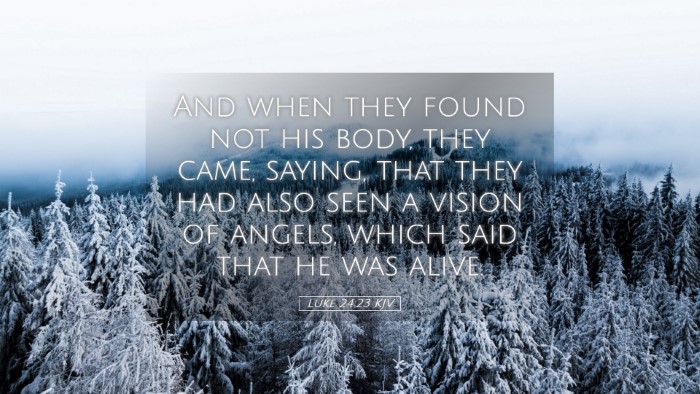Commentary on Luke 24:23
Bible Verse: Luke 24:23 - "And when they found not his body, they came, saying, That they had also seen a vision of angels, which said that he was alive."
Introduction
This verse, taken from the Gospel of Luke, is pivotal in the narrative of the resurrection of Jesus Christ. It captures a moment of confusion and revelation experienced by those who had come to the tomb. In exploring this text, we will draw insights from notable public domain commentaries, including those of Matthew Henry, Albert Barnes, and Adam Clarke, to provide a comprehensive understanding for pastors, students, theologians, and Bible scholars.
Contextual Analysis
The events surrounding Luke 24:23 occur immediately after the resurrection of Jesus. The previous verses detail the visit of the women to the tomb, where they encounter two angels who declare the resurrection to them. This moment showcases both the despair of the disciples and the jubilant confirmation of Christ’s victory over death.
Commentary Insights
A. Matthew Henry's Commentary
Matthew Henry emphasizes the dramatic shift from despair to hope evidenced in this verse. He notes the absence of Jesus' body signifies not just a loss, but a powerful promise fulfilled—the resurrection. Henry draws attention to the “vision of angels” as divine messengers, symbolizing God's intervention and the unveiling of spiritual truths. They embody a comforting assurance to believers, transforming fear into faith.
B. Albert Barnes' Notes on the Bible
Albert Barnes elaborates on the significance of the women's discovery. He points out that the angels' proclamation serves as an essential confirmation of Jesus’ teachings about his resurrection. Barnes argues that the narrative reflects the consistent biblical theme of God’s faithfulness to His promises, even amidst human doubts and fears. The ‘vision of angels’ indicates that the resurrection is not just a historical event but a spiritual reality that impacts the believer's life and faith.
C. Adam Clarke's Commentary
Adam Clarke offers a detailed examination of the Greek language used in this verse, pointing out the implications of "not found." He elaborates that this phrase shows the disbelief of the disciples, who were not prepared for the miraculous event of resurrection. Clarke highlights that the appearance of angels is a crucial element in Scripture, as they serve both as heralds of hope and as witnesses to divine acts. He reminds us that acknowledging the resurrection is central to Christian faith, setting a foundation for the hope of eternal life.
Theological Implications
This verse opens a conversation about the nature of resurrection and its implications for faith. The women's discovery and their report to the disciples underscore a shift in understanding. It moves from the physical death of Jesus to the transformative promise of new life. This moment challenges believers to re-evaluate their understanding of despair and hope, as seen in the writings of our commentators.
- Faith in the Unseen: The encounter with angels signifies faith in what is not yet visible. Both Henry and Clarke highlight the importance of believing the promises of God, even when evidence seems lacking.
- The Role of Witnesses: The women become the first witnesses to the resurrection. Their role emphasizes that God chooses the humble and marginalized to spread divine truths, as noted by Barnes.
- Continued Revelation: The vision of angels points to the ongoing nature of God's revelation. Just as the women received news from the angels, believers today are called to a continual discovery of God’s truth.
Conclusion
Luke 24:23 encapsulates a significant moment in the Christian faith—the announcement of the resurrection. The insights garnered from Matthew Henry, Albert Barnes, and Adam Clarke, provide a rich tapestry of understanding, revealing the complexities of belief, hope, and the divine promise of resurrection. As scholars, pastors, and students reflect on this verse, may they find both encouragement and challenge to deepen their faith in the risen Christ.


